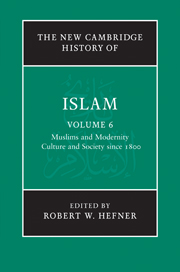Book contents
- Frontmatter
- 1 Introduction: Muslims and modernity: culture and society in an age of contest and plurality
- PART I SOCIAL TRANSFORMATIONS
- PART II RELIGION AND LAW
- 11 Contemporary trends in Muslim legal thought and ideology
- 12 A case comparison: Islamic law and the Saudi and Iranian legal systems
- 13 Beyond dhimmihood: citizenship and human rights
- 14 The ʿulamāʾ: scholarly tradition and new public commentary
- 15 Sufism and neo-Sufism
- PART III POLITICAL AND ECONOMIC THOUGHT
- PART IV CULTURES, ARTS AND LEARNING
- Glossary
- Bibliography
- Index
- References
12 - A case comparison: Islamic law and the Saudi and Iranian legal systems
from PART II - RELIGION AND LAW
Published online by Cambridge University Press: 28 March 2011
- Frontmatter
- 1 Introduction: Muslims and modernity: culture and society in an age of contest and plurality
- PART I SOCIAL TRANSFORMATIONS
- PART II RELIGION AND LAW
- 11 Contemporary trends in Muslim legal thought and ideology
- 12 A case comparison: Islamic law and the Saudi and Iranian legal systems
- 13 Beyond dhimmihood: citizenship and human rights
- 14 The ʿulamāʾ: scholarly tradition and new public commentary
- 15 Sufism and neo-Sufism
- PART III POLITICAL AND ECONOMIC THOUGHT
- PART IV CULTURES, ARTS AND LEARNING
- Glossary
- Bibliography
- Index
- References
Summary
Chapter 1 of this volume sketches the central role played by Islamic law or sharīʿa throughout the history of Islam and in the modern era. Islamic law is axiomatic to the religion, defining the religion at its most orthodox, delineating ritual practice, framing the ethics of the individual believer and the mores of the believing community and laying down a path to salvation. But Islamic law is also more: it was the framework for the laws and legal systems of a major part of the known world for over a millennium. Its age-old significance as source of law still resonates widely in legal as well as religious matters until today. This chapter focuses on sharīʿa as law and constitution in modern times.
The pre-existing Islamic legal and constitutional model: siyāsa sharʿiyya
As mentioned previously in this volume, Islamic law, in formulations that emerged gradually over the first five centuries of Islamic rule, developed an effective constitutional theory based on two complementary functions: the religious scholars or ʿulamāʾ expounding and defending their interpretation (fiqh) of the religious law (sharīʿa), and the state embodied usually in the person of the ruler with his court. The evolved theory became known by the name siyāsa sharʿiyya from about the fourteenth century, but its rudiments had been operative long before. While defined and articulated by ʿulamāʾ, it derived from and subsisted in the scholars’ ongoing negotiation with rulers, beyond the reach of books.
- Type
- Chapter
- Information
- The New Cambridge History of Islam , pp. 296 - 313Publisher: Cambridge University PressPrint publication year: 2010

